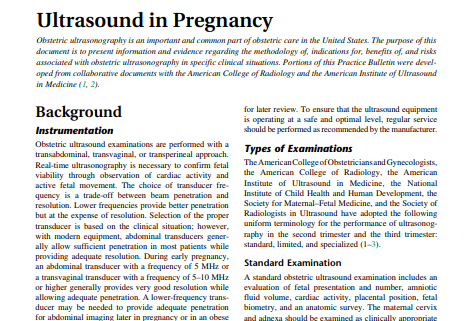ULTRASOUND IN PREGNANCY
Obstetric ultrasonography is an important and common part of obstetric care in the United States. The purpose of this document is to present information and evidence regarding the methodology of, indications for, benefits of, and risks associated with obstetric ultrasonography in specific clinical situations. Portions of this Practice Bulletin were developed from collaborative documents with the American College of Radiology and the American Institute of Ultrasound in Medicine (1, 2).
Background
Instrumentation Obstetric ultrasound examinations are performed with a transabdominal, transvaginal, or transperineal approach. Real-time ultrasonography is necessary to confirm fetal viability through observation of cardiac activity and active fetal movement. The choice of transducer frequency is a trade-off between beam penetration and resolution. Lower frequencies provide better penetration but at the expense of resolution. Selection of the proper transducer is based on the clinical situation; however, with modern equipment, abdominal transducers generally allow sufficient penetration in most patients while providing adequate resolution. During early pregnancy, an abdominal transducer with a frequency of 5 MHz or a transvaginal transducer with a frequency of 5–10 MHz or higher generally provides very good resolution while allowing adequate penetration. A lower-frequency transducer may be needed to provide adequate penetration for abdominal imaging later in pregnancy or in an obese patient. Images should be archived and easily accessible for later review. To ensure that the ultrasound equipment is operating at a safe and optimal level, regular service should be performed as recommended by the manufacturer.


